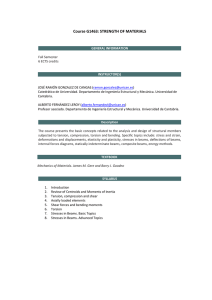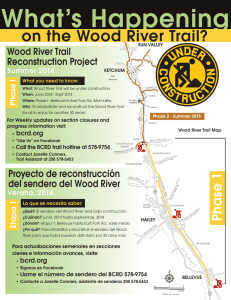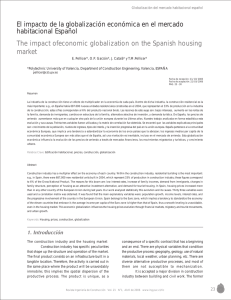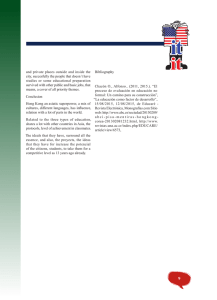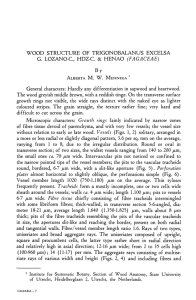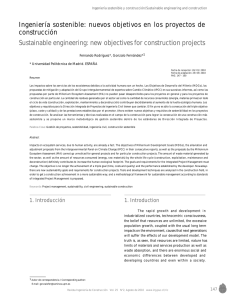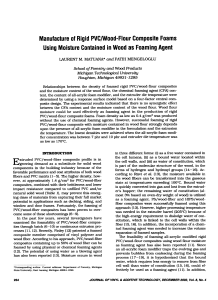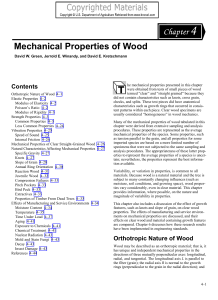Inglés
Anuncio
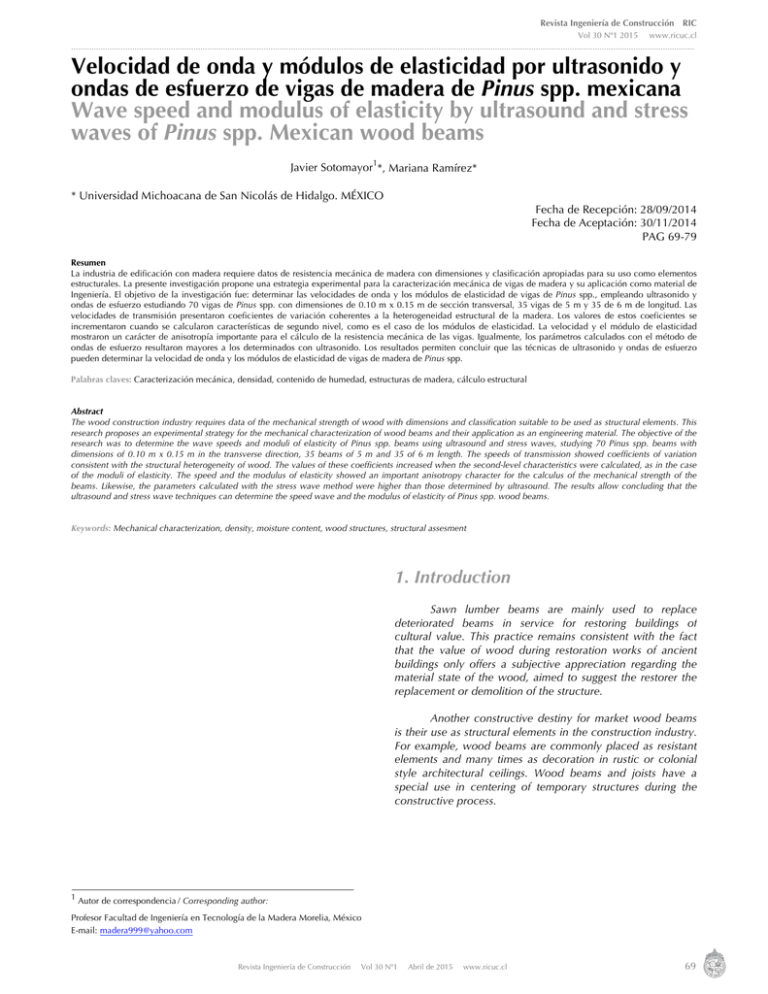
Revista Ingeniería de Construcción RIC Vol 30 Nº1 2015 www.ricuc.cl ................................................................................................................................................................................................................................................................................... Velocidad de onda y módulos de elasticidad por ultrasonido y ondas de esfuerzo de vigas de madera de Pinus spp. mexicana Wave speed and modulus of elasticity by ultrasound and stress waves of Pinus spp. Mexican wood beams 1 Javier Sotomayor *, Mariana Ramírez* * Universidad Michoacana de San Nicolás de Hidalgo. MÉXICO Fecha de Recepción: 28/09/2014 Fecha de Aceptación: 30/11/2014 PAG 69-79 Resumen La industria de edificación con madera requiere datos de resistencia mecánica de madera con dimensiones y clasificación apropiadas para su uso como elementos estructurales. La presente investigación propone una estrategia experimental para la caracterización mecánica de vigas de madera y su aplicación como material de Ingeniería. El objetivo de la investigación fue: determinar las velocidades de onda y los módulos de elasticidad de vigas de Pinus spp., empleando ultrasonido y ondas de esfuerzo estudiando 70 vigas de Pinus spp. con dimensiones de 0.10 m x 0.15 m de sección transversal, 35 vigas de 5 m y 35 de 6 m de longitud. Las velocidades de transmisión presentaron coeficientes de variación coherentes a la heterogeneidad estructural de la madera. Los valores de estos coeficientes se incrementaron cuando se calcularon características de segundo nivel, como es el caso de los módulos de elasticidad. La velocidad y el módulo de elasticidad mostraron un carácter de anisotropía importante para el cálculo de la resistencia mecánica de las vigas. Igualmente, los parámetros calculados con el método de ondas de esfuerzo resultaron mayores a los determinados con ultrasonido. Los resultados permiten concluir que las técnicas de ultrasonido y ondas de esfuerzo pueden determinar la velocidad de onda y los módulos de elasticidad de vigas de madera de Pinus spp. Palabras claves: Caracterización mecánica, densidad, contenido de humedad, estructuras de madera, cálculo estructural Abstract The wood construction industry requires data of the mechanical strength of wood with dimensions and classification suitable to be used as structural elements. This research proposes an experimental strategy for the mechanical characterization of wood beams and their application as an engineering material. The objective of the research was to determine the wave speeds and moduli of elasticity of Pinus spp. beams using ultrasound and stress waves, studying 70 Pinus spp. beams with dimensions of 0.10 m x 0.15 m in the transverse direction, 35 beams of 5 m and 35 of 6 m length. The speeds of transmission showed coefficients of variation consistent with the structural heterogeneity of wood. The values of these coefficients increased when the second-level characteristics were calculated, as in the case of the moduli of elasticity. The speed and the modulus of elasticity showed an important anisotropy character for the calculus of the mechanical strength of the beams. Likewise, the parameters calculated with the stress wave method were higher than those determined by ultrasound. The results allow concluding that the ultrasound and stress wave techniques can determine the speed wave and the modulus of elasticity of Pinus spp. wood beams. Keywords: Mechanical characterization, density, moisture content, wood structures, structural assesment 1. Introduction Sawn lumber beams are mainly used to replace deteriorated beams in service for restoring buildings of cultural value. This practice remains consistent with the fact that the value of wood during restoration works of ancient buildings only offers a subjective appreciation regarding the material state of the wood, aimed to suggest the restorer the replacement or demolition of the structure. Another constructive destiny for market wood beams is their use as structural elements in the construction industry. For example, wood beams are commonly placed as resistant elements and many times as decoration in rustic or colonial style architectural ceilings. Wood beams and joists have a special use in centering of temporary structures during the constructive process. 1 Autor de correspondencia / Corresponding author: Profesor Facultad de Ingeniería en Tecnología de la Madera Morelia, México E-mail: [email protected] Revista Ingeniería de Construcción Vol 30 Nº1 Abril de 2015 www.ricuc.cl 69 Revista Ingeniería de Construcción RIC Vol 30 Nº1 2015 www.ricuc.cl ................................................................................................................................................................................................................................................................................... Information about beams calculation can be found in handbooks and guides on design of wooden structures such as: American Society of Civil Engineers (1975), Ozelton and Baird (1976), Hoyle (1978), Faherty and Williamson (1989), Bodig (1992), American Institute of Timber Construction (1994), Morlier (1994), Smulski (1997) and Breyer et al. (2003). The wood construction industry requires data of the mechanical strength of wood with dimensions and classifications suitable to be used as structural elements. Among the most important characteristics of wood, the modulus of elasticity is the parameter used to verify the serviceability limit state and the ultimate limit in lineal regimen (Orbe et al., 2010), for the probabilistic modeling of wood structures (Köhler et al., 2007) and the structural design and evaluation of structures in service (International Organization for Standardization, 2003). Non-destructive test methods are technics that allow inspectioning materials and their components without affecting their properties, integrity and final use. These methods can be used to detect, locate, measure and evaluate defects, to determine the materials’ properties, as well as their composition, or to warrant their appropriate behavior when they are in use (Acuña et al., 2006), among others. For determining mechanical characteristics of structural wood, non-destructive tests can be used, such as ultrasound and stress waves. These tests are based on the phenomenon of the capacity of a solid body being able to transfer a mechanical wave depends on its properties, mainly on density and modulus of elasticity (Ilic, 2003; Acuña et al., 2006; Conde-García et al., 2007; Maderebner et al., 2012; Wang, 2013). The structural characterization of wood beams is geared towards the determination of the values that are necessary to assign a resistant class with static-type flexure tests (UNE-EN 384:2010, UNE-EN 338:2010, FernandezGolfin et al., 2003). Furthermore, numerical validations of standardized methods have been developed (Baño et al., 2012). Information about the use of beams in wood structures can be found, among others, in: Meyer and Kellogg (1982), Sandoz (1989), Ross and Pellerin (1994), Boström and Holmqvist (1999), American Society for Testing and Materials (2000), Forest Products Laboratory (2000), Sandoz (2000a and 2002b), Kawamoto and Williams (2002), Pellerin and Ross (2002) and Grabianowski et al. (2006). Nevertheless, the experimental values of the modulus of elasticity are scarce for beams used in the construction industry; especially those evaluated using ultrasound and stress waves. To contribute in order to the correct use of timber in the construction industry, it is advisable to develop simple methods to characterize the mechanical properties of wood beams. For example, the elasticity modulus of a wood beam is necessary to compute its structural rigidity, independently from the type and technological characteristics of the wood beam that may modify its structural response, such as its moisture content and distribution, as well as the presence and location of knots and cracking in the woody plane. Revista Ingeniería de Construcción Vol 30 Nº1 Abril de 2015 www.ricuc.cl 70 Revista Ingeniería de Construcción RIC Vol 30 Nº1 2015 www.ricuc.cl ................................................................................................................................................................................................................................................................................... One option for determining the modulus of elasticity of structural elements is applying non-destructive evaluation methods. The use of the ultrasound velocity and stress waves’ methods in wood to determine its elastic modulus are technics that have proven their efficiency on the matter (Pellerin and Ross, 2002). Researches suggest as work hypothesis, that the application of the ultrasound and stress waves’ technics allows characterizing wood beams in a non-destructive way. Moreover, this research proposes an experimental strategy for the mechanical characterization of wood beams and their application as an engineering material. The objective of the research was to determine the wave speeds and moduli of elasticity of Pinus spp. beams using ultrasound and stress waves. 2. Materials and methods 70 Pinus spp. beams were collected from sawmills in the Mexican state of Michoacán, whose dimensions were 0.10 m x 0.15 m in the transverse direction, 35 beams of 5 m and 35 of 6 m length, with average moisture content (H) of 20%. The gender and type of timber were determined in the point of collection and the botanical identification was done in the laboratorios of the Faculty of Engineering in Wood Technology. Wood beams were weigthed and their dimensions were measured; in this way, their density (ρH) was computed. Lately, the ultrasound was measured (vus) in the longitudinal direction (L) with the Sylvatest® device. The speed of the stress waves (voe) was measured with the Fakopp® device in the longitudinal (L) (Figure 1a) and the transverse direction (T) (Figure 1b) directions. Both speeds were calculated using the quotient between the distance among the wave’s emission points and the reception point, and the wave’s transmission time registered by the devices (Pellerin and Ross, 2002). The moisture content was measured with a Dostmann® hygrometer of electric resistance in three equidistant positions along each beam. The average of the three measurements was computed as the wood moisture content at the time of the tests. Once the density and the wave speed were determined, the modulus of elasticity was calculated for the moisture content at the time of the tests (20%). a) b) Figura 1. Medición del tiempo de transmisión de las ondas de esfuerzo en las vigas. a) Dirección longitudinal, b) Dirección transversal Figure 1. Measurement of the transmission time of the stress waves in beams. a) Longitudinal direction, b) Cross-section direction Revista Ingeniería de Construcción Vol 30 Nº1 Abril de 2015 www.ricuc.cl 71 Revista Ingeniería de Construcción RIC Vol 30 Nº1 2015 www.ricuc.cl ................................................................................................................................................................................................................................................................................... Afterwards, a second calculation was done to adjust density to a moisture content of 12% using the formula (Unterwieser and Schickhofer, 2010): ρ12 = ρH (1) 1 + 0.0042 * (H -12) Where: ρ12 = Wood density with a moisture content of 12% (kg/m3) ρH = Wood density with a moisture content of H (kg/m3) H = Wood moisture content of 12% Likewise, the wave speed was adjusted for moisture content varying from 20% to 12% using the formula (Unterwieser and Schickhofer, 2010): v12 = vH 1 - 0.0060 * (H -12) (2) Where: v12 = Wave speed in wood with 12% moisture content (kg/m3) vH = Wave speed in wood with H moisture content (kg/m3) H = Wood moisture content of 12% Eus = v2us ρH (3) Where: Eus = Modulus of elasticity by ultrasound (Pa) vus = Ultrasound speed (m/s) ρH = Wood density with H moisture content (kg/m3) The moduli of elasticity by stress waves were determined using the formula (Pellerin and Ross, 2002): Eoe = v2oe ρH (4) Where: Eoe = Modulus of elasticity by stress waves (Pa) voe = Speed of the stress waves (m/s) ρH = Wood density with H moisture content (kg/m3) Revista Ingeniería de Construcción Vol 30 Nº1 Abril de 2015 www.ricuc.cl 72 Revista Ingeniería de Construcción RIC Vol 30 Nº1 2015 www.ricuc.cl ................................................................................................................................................................................................................................................................................... 2.1 Experimental design The experience was designed following the recommendations of Gutiérrez-Pulido and de la Vara-Salazar (2012), which consisted in comparing the means of the parameters: modulus of elasticity using ultrasound (Eus) and modulus of elasticity using stress waves (Eoe). The response variables evaluated geared towards the longitudinal direction of observation (L). Two hundred and ten (210) reproductions were done. Stadistical calculation was done using the Statgraphics® software. Assuming a normal distribution with a mean equal to zero (x = 0) and constant variance (σ2), and independent between them; the null hypothesis H0 : x1 - x2 = 0 was verified and compared with the alternate hypothesis HA : x1 - x2 ≠ 0. The method used to discriminate among the means was Fisher’s procedure with a minimum significative difference of 95%. 3. Results and discussion Table 1 presents the arithmetical mean (x), standard deviation (σ) and coefficient of variation (CV) of the densities (ρH), velocities (vus and voe) and moduli of elasticity (Eus and Eoe) of the 70 Pinus spp. beams for two moisture contents: the experimental one at 20% and the adjusted one at 12%, and in the longitudinal (L) and cross-section (T) directions. Tabla 1. Densidades, velocidades y módulos de elasticidad de vigas de Pinus spp Table 1. Densities, velocities and moduli of elasticity of Pinus spp. beams ρH vus L Eus L voe L Eoe L voe T Eoe T (kg/m3 ) (m/s) (MPa) (m/s) (MPa) (m/s) (MPa) x! 647 4,326 12,089 4,516 13,181 1,289 1,084 σ 90 363 2,019 333 2,099 135 267 CV 0.14 0.08 0.17 0.07 0.16 0.10 0.25 ρ12 vus L Eus L voe L Eoe L voe T Eoe T (kg/m ) (m/s) (MPa) (m/s) (MPa) (m/s) (MPa) x! 626 4,544 12,905 4,744 14,071 1,354 1,158 σ 87 381 2,156 350 2240 142 285 CV 0.14 0.08 0.17 0.07 0.16 0.10 0.25 H = 20 % H = 12 % 3 H = Contenido de humedad, ρH = Densidad al 20 % de contenido de humedad, ρ12 = Densidad al 12 % de contenido de humedad, v = Velocidad de onda, us = Ultrasonido, oe = Ondas de esfuerzo, L = Dirección longitudinal, T = Dirección transversal, x! = Media aritmética, σ = Desviación estándar, CV = Coeficiente de variación. H = Moisture content, ρH = Density at 20% moisture content, ρ12 = Density at 12% moisture content, v = Wave velocities, us = Ultrasound, oe = Stress waves, L = Longitudinal direction, T = Cross-section direction, !x = Arithmetical mean, σ = Standard deviation, CV = Coefficient of varation. Revista Ingeniería de Construcción Vol 30 Nº1 Abril de 2015 www.ricuc.cl 73 Revista Ingeniería de Construcción RIC Vol 30 Nº1 2015 www.ricuc.cl ................................................................................................................................................................................................................................................................................... The values of ultrasound velocity and stress waves are consistent with the results proposed by Pellerin and Ross (2002) for wood of similar gender and density. Both the wave speed and the modulus of elasticity showed a significant difference depending on the measurement direction. The values determined in the beams’ longitudinal direction were always higher than those in the cross-section direction. Beams presented an anisotropy character in their mechanical properties. The values for the modulus of elasticity using stress waves in the longitudinal direction were 11.16 times higher than those in the cross-section direction. This anisotropy is consistent with the results suggested by Meyer and Kellogg (1982) and Breyer et al. (2003) for wood with construction-industry dimensions. Therefore, for wood beam design purposes, the difference between the magnitudes of the modulus of elasticity according to the longitudinal and cross-section directions should be considered. The values of Eus and Eoe in the longitudinal direction for wood with moisture content of 12% were 6.75% higher than those corresponding to the 20% moisture content. This result suggests a downward adjustment factor when the moisture content of wood beams increases, a phenomenon caused by the combination of high relative humidity of air and the room temperature reduction, in the place where beams are installed. Complementary technical standards for design and construction of wood structures (Government of the Federal District, Mexico, 2004) specify for class A and B structural pine wood a modulus of elasticity of 9,810 MPa and 7,848 MPa, corresponding to class A and B respectively. The results for 12% moisture content shown in Table 1 classify the studied beams in the category of class A structural wood. This classification refers to the standards of Mexico City and can be taken as a reference. However, it is recommendable to make the necessary adjustments according to the real service conditions in another city or region. It is important to highlight that the modulus of elasticity determined here refers to dynamic loading, which implies a greater magnitude compared with values determined with static loading condition, in accordance with the results proposed by Bodig and Jayne (1982) and Pellerin and Ross (2002). The values illustrate parameters for wood pieces with dimensions usually employed in the Mexican construction industry. The apparent density of wood measured with a moisture content of 20% at the time of the tests, is lower if the moisture content is adjusted to 12%. Figure 2a schematizes the distribution of the density values for moisture contents of 20% and 12%. Since there are equal or similar values, apparently the graph does not show all the values and/or experimental points. This scale effect equally applies to Figure 2b. The straight lines that limit the distribution of the experimental values represent the trends of the adjustment models of Equation (1) when the wood’s moisture content is modified with a maximum calculated density (upper straight line) and minimum one (lower straight line), for moisture contents of 20% and 12%. Revista Ingeniería de Construcción Vol 30 Nº1 Abril de 2015 www.ricuc.cl 74 Revista Ingeniería de Construcción RIC Vol 30 Nº1 2015 www.ricuc.cl ................................................................................................................................................................................................................................................................................... In contrast, the wave velocity increases if the moisture content is adjusted. Figure 2b shows the increase of ultrasound velocity in the longitudinal direction when experimental values (H = 20%) are adjusted to a moisture content of 12%. With an analytical approach similar to the density variation, the straight lines that limit the distribution of the experimental values, represent the trends of the adjustment models of Equation (2) when the wood’s moisture content is modified with a maximum wave speed (upper straight line) and minimum one (lower straight line), for moisture contents of 20% and 12%. Once the density and wave speed are adjusted, the modulus of elasticity using ultrasound and/or stress waves can be determined with Equations (3) and (4). These results are compared with the help of Table 1, which compares the average values for modulus of elasticity Eus, when going from a moisture content of 20% to 12%. Figura 2. Distribución de los valores de: a) Densidad (ρ) y b) Velocidad de onda del ultrasonido (vus), en función del contenido de humedad (H) Figure 2. Distribution of the values for: a) Density (ρ) and b) Ultrasound wave speed (vus), in terms of moisture content (H) Revista Ingeniería de Construcción Vol 30 Nº1 Abril de 2015 www.ricuc.cl 75 Revista Ingeniería de Construcción RIC Vol 30 Nº1 2015 www.ricuc.cl ................................................................................................................................................................................................................................................................................... This arithmetical comparison of average values suggests a difference in the magnitude of the studied modules (Eoe L / Eus L = 1.09). However, if each beam’s experimental values for moduli of elasticity are illustrated in a graph, it is not easy to identify this difference. Therefore, it is complicated to choose an experimental value to use it in product design or for structural calculation. Figure 3 presents the distribution of the values for moduli of elasticity using stress waves (Eoe) and ultrasound (Eus) in terms of density (ρH). None of the moduli of elasticity values is lower than the lower limit proposed by the UNE 338 standard (UNE-EN 384:2010) and nearly 5% is higher than the corresponding upper limit. For practical purposes, the magnitude of the moduli of elasticity between the two studied techniques is confused. Figura 3. Distribución de los valores de los módulos de elasticidad por ondas de esfuerzo (Eoe) y por ultrasonido (Eus) en función de la densidad (ρH ) Figure 3. Distribution of the values for moduli of elasticity using stress waves (Eoe) and ultrasound (Eus) in terms of density (ρH ) In order to resolve this ambiguity, a Student's t-test was made for comparing two means, with the null hypothesis H0 : x1 - x2 = 0, for a 95% significance value. The test was applied to the experimental values (H = 20%) and the adjusted values (H = 12%). Results are presented in Table 2. An analogue analysis was carried out for the tests’ stress wave data, with similar results. Revista Ingeniería de Construcción Vol 30 Nº1 Abril de 2015 www.ricuc.cl 76 Revista Ingeniería de Construcción RIC Vol 30 Nº1 2015 www.ricuc.cl ................................................................................................................................................................................................................................................................................... Tabla 2. Pruebas t-Student para módulos de elasticidad Table 2. Student’s t-test for moduli of elasticity H = 20 % H = 12 % H : x!! − x! ! = 0 Ultrasonido E L E L - x! 12.089 12.905 Se rechaza/ Rejected Ondas de esfuerzo Eoe L Eoe L - x! 13.181 14.071 Se rechaza/ Rejected us 0 us H = Contenido de humedad, E = Módulo de elasticidad, us = Ultrasonido, oe = Ondas de esfuerzo, L = Dirección longitudinal, H0 = Hipótesis nula, x! = Media aritmética. H = Moisture content, E = Modulus of elasticity, us = Ultrasound, oe = Stress waves, L = Longitudinal direction, H0 = Null Hypothesis, 𝑥̅ = Arithmetical mean The rejection of the null hypothesis between the means confirms that, for practical purposes, wood’s moisture content should be considered: the values of the modulus of elasticity are higher when the moisture content decreases. However, the modulus of elasticity is a material’s univocal characteristic, regardless of the method employed for its determination. In this case study, the reason that explains the differences between the magnitudes obtained through the selected technique remains ambiguous: the loading direction was the same, that is, in the longitudinal direction; the theoretical model was similar, represented by the equations used, and measurements were made on the same material, that is, on the same beams, with the same moisture content and structural characteristics. Figure 4 presents the lineal correlation between the modulus of elasticity using stress waves, in terms of the modulus of elasticity using ultrasound, both in the longitudinal direction. This result with a high coefficient of determination (R2) suggests that the ultrasound technique is a good predictor of the modulus of elasticity using stress waves. Figura 4. Módulo de elasticidad por ondas de esfuerzo (Eoe) en función del módulo de elasticidad por ultrasonido (Eus). Ambos en la dirección longitudinal (L). R2 = Coeficiente de determinación Figure 4. Modulus of elasticity using stress waves (Eoe) in terms of the modulus of elasticity using ultrasound (Eus). Both in the longitudinal direction (L). R2 = Coefficient of determination Revista Ingeniería de Construcción Vol 30 Nº1 Abril de 2015 www.ricuc.cl 77 Revista Ingeniería de Construcción RIC Vol 30 Nº1 2015 www.ricuc.cl ................................................................................................................................................................................................................................................................................... 4. Conclusions The ultrasound and stress wave techniques allowed determining the wave speed and the moduli of elasticity of seventy Pinus spp. wood beams. The transmission speeds presented coefficients of variation consistent with the material heterogeneity of wood. The values of these coefficients increased when the secondlevel characteristics were calculated, such as the modulus of elasticity. Speed and the modulus of elasticity showed a significant anisotropy character for the mechanical strength calculation of the beams. Values determined in the longitudinal direction of the beams were always higher than those of the cross-section direction. The measurements of the modulus of elasticity determined on beams with moisture contents higher than 12% should be adjusted to a moisture content recommended by the standard in force and/or to the service conditions of the beams. The values of the modulus of elasticity in the longitudinal direction present a statistically significant numerical difference according to the techniques used for its determination. Parameters calculated with the stress wave method were higher than those determined with ultrasound. 5. Referencias/References Acuña L., Díez M. R., Casado M. (2006), Los ultrasonidos y la calidad de la madera estructural. Aplicación a Pinus pinaster ait. Boletín Informativo CIDEU, 2, 7-26. American Society for Testing and Materials (2000), ASTM D-198. Standard Test Methods of Static Tests of Lumber in Structural Sizes, Annual Book of ASTM Standards, Section Four; Construction, Volume 04.10, Wood, USA. American Society of Civil Engineers (1975), Wood Structures: A Design Guide and Commentary, American Society of Civil Engineers, USA. Baño V., Arguelles-Bustillo R., Regueira R., Guaita M. (2012), Determinación de la curva tensión-deformación en madera de ‘Pinus sylvestris’ L. para la simulación numérica de vigas de madera libre de defectos, Materiales de Construcción, 62, 306, 269-284. Bodig J., Jayne B.A. (1982), Mechanics of Wood Composites, Van Nostrand Reinhold, USA. Bodig J. (1992), Editor, Reliability-Based Design of Engineered Wood Structures, Series E: Applied Sciences, Vol. 215, Kluwer Academic Publishers, The Netherlands. Boström L., Holmqvist C. (1999), State of the art on machine strength grading, in: First RILEM symposium on timber engineering, Stockholm, Sweden. Swedish National Testing and Research Institute, Rilem Publications, pp: 513-522. Breyer D. E., Fridley K. J., Pollock D. G., Cobeen K. E. (2003), Fifth edition, Design of Wood Structures ASD, McGraw-Hill, USA. Conde García M., Fernández-Golfín Seco J. I., Hermoso Prieto E. (2007), Mejora de la predicción de la resistencia y rigidez de la madera estructural con el método de ultrasonidos combinado con parámetros de clasificación visual, Materiales de Construcción, 57, 288, 49-59. Faherty K. F., Williamson T. G. (1989), Editors, Third edition, Wood Engineering and Construction Handbook, McGraw-Hill, USA. Fernández-Golfin J. I., Diez M. R., Hermoso E. (2003), Relationships between grade determining properties of Spanish Scots and Laricio Pine structural timber, Materiales de Construcción, 53, 270, 44-45. Forest Products Laboratory (2000), Stress wave timing nondestructive evaluation tools for inspecting historic structures, A guide for use and interpretation, Gen. Tech. Rep. FPL-119. U.S. Department of Agriculture, Forest Service, Forest Products Laboratory, USA. Gobierno del Distrito Federal (2004), Normas técnicas complementarias para diseño y construcción de estructuras de madera, I: 103-BIS, Gaceta Oficial del Distrito Federal, México. Grabianowski M., Manley B., Walker J. C. F. (2006), Acoustic measurements on standing trees, logs and green lumber, Wood Science and Technology, 40, 205-216. Gutiérrez Pulido H., de la Vara Salazar R. (2012), 3ª Edición, Análisis y diseño de experimentos, Mc Graw Hill, México. Hoyle R. J. Jr. (1978), Wood technology in the Design of Structures, Fourth edition, Mountain Press Publishing, USA. Ilic J. (2003), Dynamic MOE of 55 species using small wood beams, Holz als Roh- und Werkstoff, 61, 167-172. International Organization for Standardization (2003), International Standard ISO 13822, Bases for design of structures - Assessment of existing structures, Belgium. Kawamoto S., Williams R. S. (2002), Acoustic emission and acousto-ultrasonic techniques for wood and wood-based composites, A review, Gen. Tech. Rep. FPL-GTR-134, Department of Agriculture, Forest Service, Forest Products Laboratory, USA. Köhler J., Sørensen J. D., Faber M. H. (2007), Probabilistic modeling of timber structures, Structural Safety, 29, 255-267. Revista Ingeniería de Construcción Vol 30 Nº1 Abril de 2015 www.ricuc.cl 78 Revista Ingeniería de Construcción RIC Vol 30 Nº1 2015 www.ricuc.cl ................................................................................................................................................................................................................................................................................... Maderebner R., Anton Kraler A., Beikircher W. K., Flach M. (2012), Influence on measuring results by knottiness of ultrasound measurements of bending stress-section spruce wood beams, In: World Conference on Timber Engineering, Pierre Quenneville (ed.), pp: 83-91, Auckland, New Zealand. Meyer R. W., Kellogg R. M. (1982), Editors, Structural Use of Wood in Adverse Environments, Society of Wood Science and Technology, Van Nostrand Reinhold, USA. Morlier P. (1994), Editor, Creep in Timber Structures, Report of RILEM Technical Committee 112-TSC, Chapman & Hall, England. Orbe A., Cuadrado J., Rojí E., Maturana A. (2010), Arquitectura y Madera, Guía de diseño de elementos estructurales adaptada al CTE, Servicio Central de Publicaciones del Gobierno Vasco, España. Ozelton E. C., Baird J. A. (1976), Timber Designer’s Manual, England. Pellerin R. F., Ross R. J. (2002), Nondestructive Evaluation of Wood, Forest Products Society, USA. Ross R. J., Pellerin R. F. (1994), Nondestructive testing for assessing wood members in structures: A review, Gen. Tech. Rep. FPL-GTR-70 (Rev.), Department of Agriculture, Forest Service, Forest Products Laboratory, USA. Sandoz J. L. (1989), Grading of construction timber by ultrasonic, Wood Science and Technology, 23, 95-108. Sandoz J. L. (2000a), Wood Testing Using Acousto–Ultrasonic, Publication IBOIS 00:23, Institut de Statique et Structures IBOIS, Construction en Bois, in: Proceedings of the World Conference on Timber Engineering (WCTE 2000), Whistler Resort, British Columbia, Canada. Sandoz J. L. (2002b), High Performance Timber by Ultrasonic Grading, Publication IBOIS 00:20, Institut de Statique et Structures IBOIS, Construction en Bois, in: Proceedings of the 7th World Conference on Timber Engineering (WCTE 2002), MARA University of Technology, Malaysia. Smulski S. (1997), Editor, Engineered Wood Products, A Guide for Specifiers, Designers and Users, PFS Research Foundation, USA. UNE-EN 384:2010. (2010), Madera Estructural. Determinación de los valores característicos de las propiedades mecánicas y la densidad, Asociación Española de Normalización y Certificación, Madrid. UNE-EN 338:2010. (2010), Madera Estructural. Clases resistentes, Asociación Española de Normalización y Certificación, Madrid. Unterwieser H., Schickhofer G. (2010), Influence of moisture content of wood on sound velocity and dynamic MOE of natural frequency and ultrasonic runtime measurement, European Journal of Forest Products, 69(2), 171-181. Wang X. (2013), Stress Wave E-Rating of Structural Timber-Size and Moisture Content Effects. In: Proceedings: 18th International Nondestructive Testing and Evaluation of Wood Symposium, Ross, R.J., Wang, X. (eds.) General Technical Report FPL-GTR-226, pp: 38-46, Madison, WI: U.S, Department of Agriculture, Forest Service, Forest Products Laboratory, USA. Revista Ingeniería de Construcción Vol 30 Nº1 Abril de 2015 www.ricuc.cl 79
